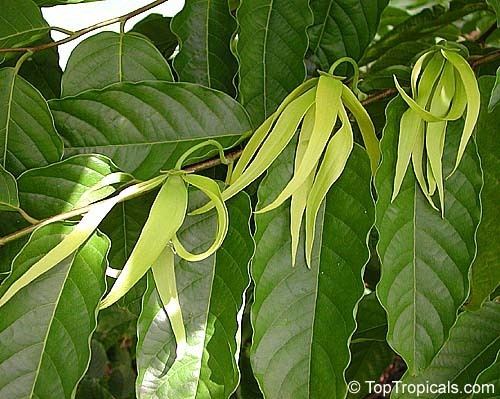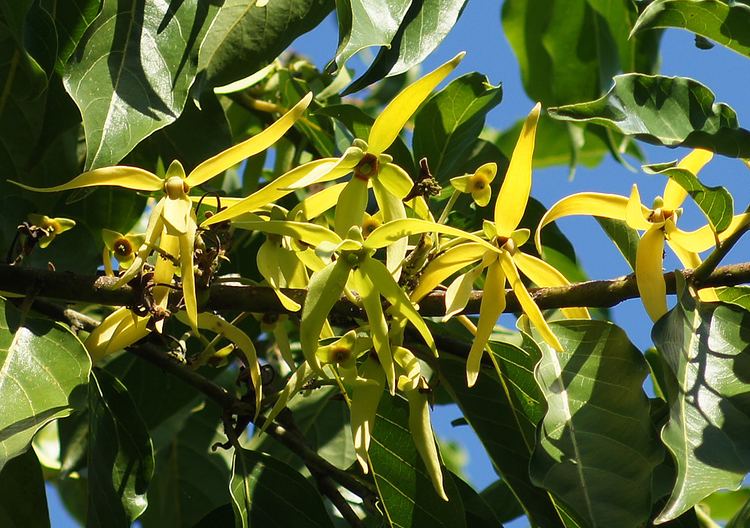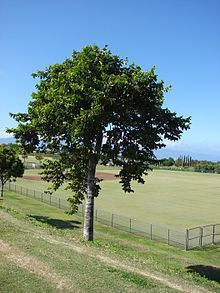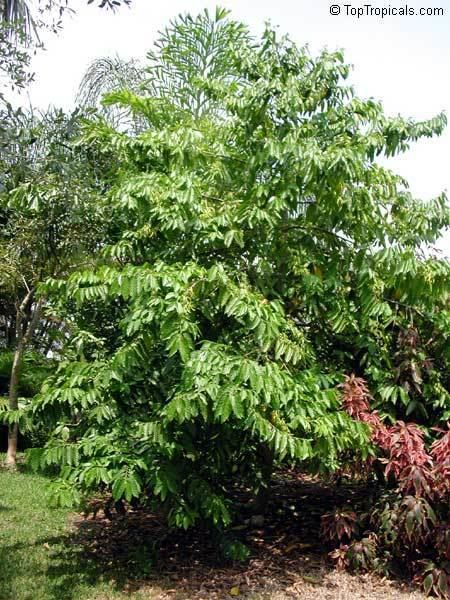Rank Species | Genus Cananga Higher classification Cananga | |
 | ||
Similar Patchouli, Bergamot orange, Jasmine, Vetiver, Lavender | ||
Cananga odorata ylang ylang tree flower of flowers chanel no 5 perfume flowers
Cananga odorata, known as the cananga tree (Indonesian: kenanga, Balinese: sandat, Acehnese: seulanga, Filipino: ilang-ilang, Ilocano: allangigan), is a tropical tree that originates in Indonesia, which in early 19th century spread to Malaysia and the Philippines. It is valued for the perfume extracted from its flowers, called ylang-ylang /ˈiːlæŋ ˈiːlæŋ/ EE-lang-EE-lang (a name also sometimes used for the tree itself), which is an essential oil used in aromatherapy. The tree is also called the fragrant cananga, Macassar-oil plant, or perfume tree. Traditional Polynesian names include Mata‘oi (Cook Islands), Mohokoi (Tonga), Moso‘oi (Samoa), Moto‘oi (Hawai), Mokosoi/Mokasoi/Mokohoi (Fiji).
Contents
- Cananga odorata ylang ylang tree flower of flowers chanel no 5 perfume flowers
- Cananga odorata ylang ylang
- Etymology
- Description
- Distribution and habitat
- Ecology
- Uses
- Characteristics
- Chemical constituents
- References

The ylang-ylang vine (Artabotrys odoratissimus) and climbing ylang-ylang (Artabotrys hexapetalus) are woody, evergreen climbing plants in the same family. Artabotrys odoratissimus is also a source of perfume.

Cananga odorata ylang ylang
Etymology

The name ylang-ylang is derived from the Tagalog term ilang-ilang for the tree that is a reduplicative form of the word ilang, meaning "wilderness", alluding to the tree's natural habitat. A common mistranslation is "flower of flowers".
Description

Cananga odorata is a fast-growing tree of the custard apple family Annonaceae. Its growth exceeds 5 m (16 ft) per year, and it attains an average height of 12 m (39 ft) in an ideal climate. The evergreen leaves are smooth and glossy, oval, pointed and with wavy margins, and 13–20 cm (5–8 in) long. The flower is drooping, long-stalked, with six narrow, greenish-yellow (rarely pink) petals, rather like a sea star in appearance, and yields a highly fragrant essential oil.
Cananga odorata var. fruticosa, dwarf ylang-ylang, grows as small tree or compact shrub with highly scented flowers.
Distribution and habitat

The plant is native to the Philippines, Malaysia and Indonesia and is commonly grown in Madagascar, Polynesia, Melanesia, Micronesia and Comoros Islands. It grows in full or partial sun, and prefers the acidic soils of its native rainforest habitat. Ylang-ylang has been cultivated in temperate climates under conservatory conditions.
Ecology
Its clusters of black fruit are an important food item for birds, such as the collared imperial-pigeon, purple-tailed imperial-pigeon, Zoe's imperial-pigeon, superb fruit-dove, pink-spotted fruit-dove, coroneted fruit-dove, orange-bellied fruit-dove, and wompoo fruit-dove. Sulawesi red-knobbed hornbill serves as an effective seed disperser for C. odorata.
Uses
The essential oil is used in aromatherapy. It is believed to relieve high blood pressure, normalize sebum secretion for skin problems, and is considered to be an aphrodisiac. According to Margaret Mead, it was used as such by South Pacific natives such as the Samoan Islanders where she did much of her research. The oil from ylang-ylang is widely used in perfumery for oriental or floral themed perfumes (such as Chanel No. 5). Ylang-ylang blends well with most floral, fruit and wood scents.
In Indonesia, ylang-ylang flowers are spread on the bed of newlywed couples. In the Philippines, its flowers, together with the flowers of the sampaguita, are strung into a necklace (lei) and worn by women and used to adorn religious images.
Ylang-ylang's essential oil makes up 29% of the Comoros' annual export (1998).
Ylang-ylang is a common flavoring in Madagascar for ice cream.
Characteristics
The fragrance of ylang-ylang is rich and deep with notes of rubber and custard, and bright with hints of jasmine and neroli. The essential oil of the flower is obtained through steam distillation of the flowers and separated into different grades (extra, 1, 2, or 3) according to when the distillates are obtained. The main aromatic components of ylang-ylang oil are benzyl acetate, linalool, p-cresyl methyl ether, and methyl benzoate, responsible for its characteristic odor.
Chemical constituents
Typical chemical compositions of the various grades of ylang-ylang essential oil are reported as:
